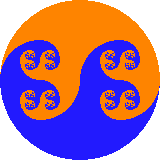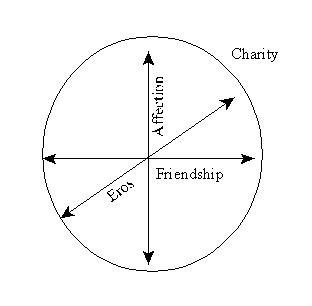
“The Four Loves” as a Metaphor for Evolution
Warning: This is not a review of Clive S. Lewis’ work, and has nothing to do with its moral implications. I just consider Lewis’ classification useful for describing evolutionary processes.
C. S. Lewis makes distinctions of different types of love. The first distinction he makes is between need-love and gift-love. Need-love is demanding, like a child to a mother, and gift-love is giving, like a mother to a child. But it is important to note that gift-love can also be a need-love: a mother can have the need of giving her love to her child. This involves a personal satisfaction in the gift-love.
The distinction of types of love which gives title to the book considers affection, friendship, Eros, and charity. Lewis notes that it is rare when these come alone, so in most cases we should expect a mixture of them. Affection can be seen as the type of love a mother can feel for a son, but also a son for a mother. It can be more general. It can be the love for an old employee or for a faithful pet. Friendship can be seen when people share common interests. The common interests draws a boundary between “us” (the friends) and “them” (the rest). Eros is the love of a couple. Lewis distinguishes it from Venus, which consists in the sexual instinct and satisfaction. Charity is the type of love which is given without interest. It could be seen as “pure” gift-love. Charity can be applied to all the other types of love.
The four types of love cannot be explained purely in terms of evolutionary theory. For example, Lewis notes that friendship has no survival value, but it gives value to survival. They do have an evolutionary basis, but they have a very strong cultural component, which might not be of survival advantage. For example, Lewis notes that a couple feeling erotic love for each other has no guarantee of producing better offspring. Moreover, during centuries procreation has had more to do with arranged marriages, rapes, and slavery, than with passionate love. Probably love has no evolutionary explanation, but we can identify the biological counterparts of the four types of love.
We could say that the biological counterpart for affection is nurture instinct. There should be a mechanism to make parents care for their offspring, and of the offspring to ask for that care. The counterpart of friendship would be cooperation or collaboration. Organisms doing the same thing are better if they join efforts than if each one does its thing alone. Therefore, a mechanism is favoured for constraining behaviours in order to promote cooperation. Eros is quickly related with reproduction instinct, or Venus. Organisms need a mechanism which prompts them to reproduce, otherwise their species would not survive. We can say that the biological counterpart of charity is altruism. It is the same concept, but in a broader sense: organisms give part or all of their resources to the profit of the community. A clear example of this is seen in social insects such as ants and bees, where individuals can sacrifice themselves for the benefit of the colony or hive.
|
Love |
Biological counterpart |
|
affection |
nurture instinct |
|
friendship |
collaboration, cooperation |
|
Eros |
reproduction instinct |
|
charity |
altruism |
We can see that the biological counterparts of love are required for the evolution of species. Since our culture has complexified our societies and environments (which in turn complexify our culture), it copes with the biological needs in complicated ways. These are what we can describe as love.
Lewis describes friendship as being side by side, while Eros as being face to face. We can extend this, since affection can be seen as a top-down relationship. In this sense, we can make a diagram of the four loves in the Cartesian space, where the y axis would be affection, the x axis friendship, and the z axis Eros. Charity would give a higher value to any of the dimensions.

We can use Lewis classification metaphorically to describe (and probably later explain?) meta-system transitions (MST) (Turchin, 1977). A MST occurs when individuals integrate to form a greater whole. A classic example of a MST is the transition from unicellular to multicellular organisms: unicellular organisms integrate and differentiate in order to produce an organized whole, with more capabilities than the individuals themselves.
Affection, friendship, and Eros are required for the development of individuals. Not only humans need to take care of their offspring, cooperate, and reproduce, in order to survive. But the meta-system transition is given when charity dominates in all the love dimensions: organisms “care” more about others than about themselves, without interest. Only if a group of cells do this they can form a multicellular organism.
We can use the loves to describe metaphorically their biological counterparts. But we can also do it to describe other types of MST, of course noting clearly that it is a metaphor.
Could we use this metaphor to predict new MST? For example, what is required of humans to integrate completely into social organisms? We could say that full charity: caring more about others without any interest makes the society more important than the individuals. We should note that this is a gradual process, and we cannot wake up one day and say “Oh, dear!, a MST just happened!”. The interactions between individuals are always there (at least spatially), only that they become more refined as they approach a MST. On the other hand, if we would have a MST towards social organisms, how could we tell? Can our cells tell that they are forming humans? Probably the MST has been made, and we have not noticed. This is because in many cases we can see full charity: soldiers dying for their motherland, human right activists, and of course charity organizations. The question remains open...
In any case, love could be seen as a driving force in evolution (i.e. a description of a process). It is at least a necessary condition of evolution. Of course this is independent of moral judgements, since “good” and “bad” are relative (Gershenson, 2002). It is through charity that individuals “renounce” to some of their freedom, for the benefit of the whole (which actually can benefit them in the long run, and give them new freedoms. For example, a cell is better protected in a multicellular organism than alone; a worker is better protected in an union than being independent). The integration allows diversification and specialization, since individuals need to spend less effort for survival, if everyone is helping each other, then functions can be delegated into specialists. Otherwise, everyone would need to try to do everything on his own, and this is not good business. The profit that individuals receive from charity lies in the fact that integrated wholes have more capabilities than the less integrated ones.
Of course, you need to take care of “free riders” (Dawkins, 1989). When there is cooperation, a “free rider” might take advantage of the work of others, without giving anything in return. But this is not good for the cooperative, and on the long run not even for the free rider(s), since they do not have anymore someone to exploit. A mechanism, a mediator (Heylighen, 2003), should emerge in order to prevent free riding. So we can say that cooperation/friendship plus mediation can result in altruism/charity. Nurture and reproduction allow survival, and the others integration, which means better survival as a whole. Mediation in nurture/affection and reproduction/Eros can also lead to charity in their dimensions. But then, how independent of love is this mediation?
Free riding should not be seen from a moral perspective, and judged as a bad thing. If everyone would “play by the rules”, evolution would reach an equilibrium. It is the fact that organisms “cheat”, in other words change the rules, that the “cheated” try to adapt to them, and others will try to find other ways to keep on profiting, changing the rules of others. It is this eternal struggle which drives evolution. It is because of this that the biosphere does not reach a boring equilibrium, as predicted by the second law of thermodynamics (Kauffman, 2000). We have also to see the problem from different perspectives: what for one species is free riding or parasitism, for another is a way of making a living. Differences of context will always bring conflicts. Continuing with our metaphor, a lion does not hunt a zebra because it “does not love” it, but precisely because it “loves” the cubs she will feed with a successful hunt. And the zebra tries to evade the lion for the same reason: to be able to feed its foal, and we can describe this as love. It is only that love in different contexts creates conflicts. It is the balance between love and conflicts which drives evolution.
We now step out of our metaphor, and consider love in human cultures.
As mentioned above, we cannot explain the emergence of love in terms of evolutionary advantage, since it consists of its biological counterparts (which can be explained by evolutionary theory), immersed in very complex cultures. Why do we love? Why do we love the way we love? Well, probably those are ill-posed questions. What we can say is that actually love could be seen as a type of mediator (we should note that there are other mediators, such as laws, money, police, and anything which can constrain the possibility of free riding). If we have instincts and moral norms which restrain us from cheating others, they should prevail, since they give a benefit both to individuals and groups.
There is the theory that laughter (only humans seem to laugh) emerged as a way of distinguishing friends from enemies, since it is harder to fake than a smile. It is plausible to think that the four types of love act as mediators in our complex cultures to prevent cheating and conflicts. If you feel any type of love for someone, it will be harder that you will cheat the person. But then if someone tries to imitate love, to take advantage of others, then the mechanism of love should complexify even more in order to detect cheaters. I believe that this could be an explanation of why we have love in our cultures. At the end, love helps us to get along better. We already knew that! But now we know a bit more about how this occurs.
So that is how we have it: love as a motor and product of evolution. It depends on how we observe it.
Dawkins, R. (1989). The Selfish Gene, New Edition. Oxford University Press.
Gershenson, C. (2002). Complex Philosophy. Proceedings of the 1st Biennial Seminar on Philosophical, Methodological & Epistemological Implications of Complexity Theory. La Habana, Cuba. Also in InterJournal of Complex Systems, 544. http://uk.arxiv.org/abs/nlin.AO/0109001
Heylighen, F. (2003). Mediator Evolution: a general scenario for the origin of dynamical hierarchies. Unpublished. http://pcp.vub.ac.be/Papers/MediatorEvolution.pdf
Kauffman, S. (2000). Investigations. Oxford University Press.
Lewis, C. S. (1971). The Four Loves. Harcourt Brace International.
Turchin, V. (1977). The Phenomenon of Science. Columbia University Press. http://pespmc1.vub.ac.be/POSBOOK.html